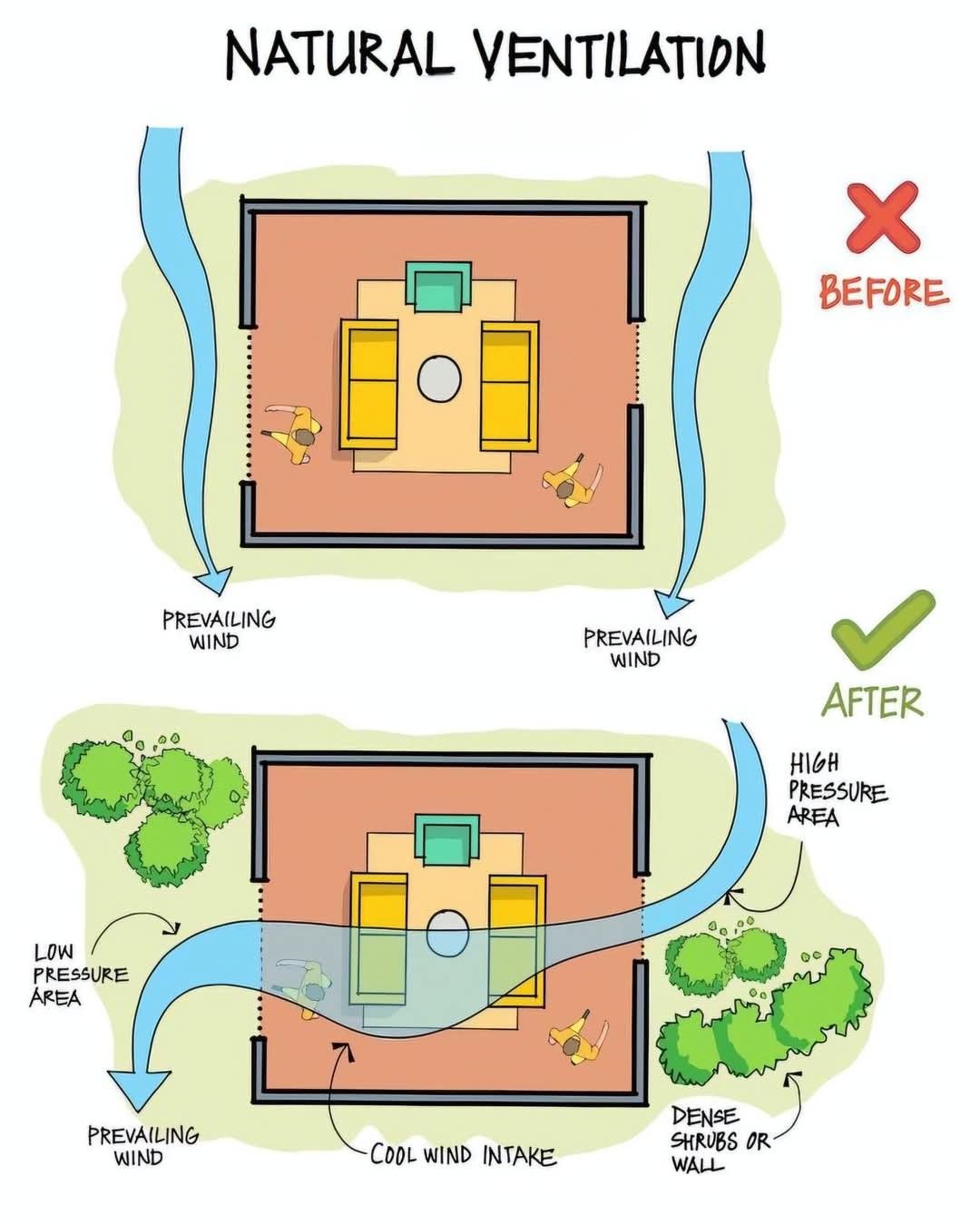A Simple Design Adjustment That Transforms Comfort, Cuts Costs, and Protects the Planet

In the age of sustainability, architects, engineers, and homeowners are constantly seeking smarter ways to reduce energy use without compromising comfort. Among the simplest yet most effective solutions is natural ventilation. The image you provided beautifully illustrates the “before” and “after” of how a home’s design can either fail or succeed at capturing the free, renewable power of the wind.
Let’s break down the concept in detail.
🌬 What Is Natural Ventilation?
Natural ventilation is the process of supplying and removing air through indoor spaces without using mechanical systems like fans or air conditioners. It uses wind pressure, temperature differences, and clever design strategies to bring in cool air and flush out hot, stale air.
Think of it as letting the building breathe—like opening lungs for fresh oxygen.
🚫 The “Before” Scenario: A Missed Opportunity
In the “before” setup, prevailing winds flow past the house but fail to enter effectively. Why?
Blocked air pathways: Solid walls with no strategically placed openings restrict airflow.
No pressure difference: Wind needs an entry (low pressure) and exit (high pressure) to circulate. Without it, air just bypasses the building.
Overheated interiors: With no fresh breeze, the home relies on artificial cooling, increasing energy bills and discomfort.
This type of design is common in many urban and suburban homes, where aesthetics often overshadow function.
✅ The “After” Scenario: A Breath of Fresh Air
The improved design integrates natural ventilation principles, showing how small changes can make a huge difference:
Cool Wind Intake: Openings on the windward side create low-pressure zones that pull fresh air indoors.
Cross Ventilation: Openings on the opposite side (leeward) allow air to escape, setting up a continuous flow.
Dense Shrubs & Walls: Landscaping helps guide wind and filter dust, enhancing indoor air quality.
Pressure Balance: By leveraging high- and low-pressure areas, the building becomes a channel for air movement instead of a barrier.
Result? A home that’s naturally cooler, fresher, and less dependent on costly mechanical cooling.
🌱 Why Natural Ventilation Matters Today
Natural ventilation isn’t just about comfort—it’s about sustainability and health.
Energy Savings: Reduces the need for air conditioners, cutting electricity bills.
Eco-Friendly: Lowers carbon footprint by decreasing reliance on fossil-fuel-driven power.
Healthier Homes: Improves indoor air quality by reducing humidity, toxins, and stale air.
Resilience: Keeps homes livable during power outages or heatwaves.
According to studies, buildings that effectively use natural ventilation can cut cooling energy use by up to 60%.
🏡 Practical Applications for Homeowners
If you’re planning a home or renovation, here are easy steps to apply natural ventilation strategies:
Cross Ventilation Design: Ensure openings (windows, vents, doors) are placed opposite each other to allow airflow.
Use Landscaping Wisely: Trees and shrubs can guide breezes into your home while shading walls.
Vary Window Heights: Place windows at different levels to allow hot air (which rises) to escape while cool air enters.
Courtyards & Atriums: Create central open spaces that act as natural “air lungs” for the building.
Avoid Over-Sealing: While insulation is vital, homes also need breathable zones for air exchange.
🏙 Beyond Homes: Cities Can Benefit Too
Urban planners can apply the same concept on a larger scale. For instance:
Designing streets that align with prevailing winds.
Planting green corridors to channel breezes.
Positioning buildings to avoid creating “heat traps.”
Cities like Singapore have already adopted these methods, making urban life more bearable in tropical climates.
🌍 The Future: Blending Tradition and Innovation
What’s fascinating is that natural ventilation is not new—it’s ancient wisdom. Traditional houses in hot regions (think Middle Eastern courtyards or Mediterranean villas) were masters at capturing wind. Today, modern science validates and enhances those principles with advanced modeling and design tools.
By blending old wisdom with new technology, we can create homes and cities that are:
✔ Cooler
✔ Healthier
✔ More sustainable
✨ Final Thought
The image is a powerful reminder that good design isn’t just about aesthetics—it’s about harmony with nature. A wall placed wrong can make a house suffocating, while a window positioned right can transform it into a cool, breathable sanctuary.
Natural ventilation is free, renewable, and available everywhere. The question is: are we designing our spaces to welcome it in?